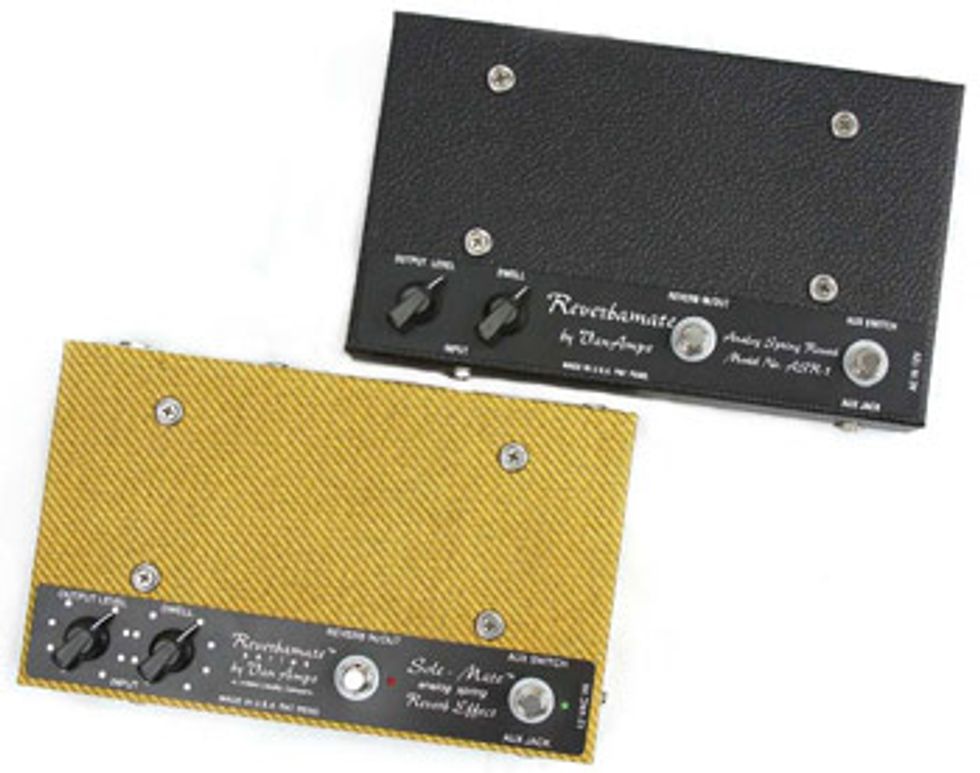 |
There is, however, a difference in how the reverberated signal is handled in the two units. In the ASR-1, the reverb signal is routed to a 1/4" output jack on the rear panel, where it sits next to another jack that outputs the dry signal. The Sole-Mate, on the other hand, mixes the reverb signal with the dry signal at the same output jack, a more commonly used routing, as found in the venerable Fender reverb tanks. Both VanAmp units use the same model 8" Accutronics spring unit, which is hard-mounted to the aluminum chassis. Both units also run off a12V AC wall wart, but the ASR-1 also has two internal 9V DC batteries that can be used for power. Both chassis are covered with either a Tweed fabric or brown, cream or black Tolex, in addition to a host of custom colors.
Other identical features are two footswitches on the top of the chassis: one for switching the reverb on and off (doesn’t affect the dry signal) and one labeled “Aux”, which allows a cable to run from the footswitch jack of a built-in effect or an amp channel switch to the aux input jack, which allows centralized control of both parameters.
The ASR-1 is not useable with amps with a single input jack, and efforts to Y-cord the outputs together creates a dangerous feedback loop. It is, however, useable with one channel amps that have two inputs by using the output control to bring the reverb signal up to desired level in the mix. The Sole-Mate was created for those amps with a single input jack. Another difference between the two units is that the Sole-Mate has a reverb status light and a power light, while the ASR-1 does not.
Plugging In
I tried out the Sole-Mate first and found it to be very sweet sounding. The delay was of medium duration and the tail had that full, sustained sound that seems to be the hallmark of the great spring units. I thought the tails sounded especially good in the higher ranges, a place where some reverbs sound a bit harsh. I also found the overall sound a bit on the dark side, which wasn’t bad, but I found myself wishing for a bit more tone control—not a biggie, though.
The dwell control took us from a shadow of reverb to full-out cavernous thunder. Fender has the surf sound locked down, partially because of the behavior of the longer springs mechanically, and partly because of the longer delay, so it was difficult to get what I considered an authentic surf tone. Nonetheless, the Sole-Mate is definitely a first-rate spring tone for everything else, and VanAmps informs us that there is a long decay spring tank available on special order that will bring the performance solidly into the surf realm.
The ASR-1 solved the tone problem by its split output. Using a two-channel amp, I could adjust reverb tone to taste using the EQ of the dedicated reverb channel. The unit itself seemed to have higher output than the Sole-Mate, and it had a bit of a tendency to feedback and overdrive the amp at ridiculously high settings. It was, however, nice to be able to place a distortion device on the clean output and not have to deal with the questionable sonic qualities of a distorted reverb. What was really cool was using a separate amp for the reverb signal and putting some space between the two amps, which yielded reverbzilla in stereo.
The obvious comparison question is VanAmps vs. Fender. For my money, I’m taking the Van. It fits in my gig bag and has all the sweet reverb I need. If you’re a surfer dude, get the Fender and plug her into your dual Showman with JBL’s. The Reverbmates’ shortcomings were few, but included the lack of a tone control on the Sole-Mate, and no lights on the ASR-1. Both Van units “boinged” when hit or dropped, but nowhere near as bad as the Fender units. Don’t plan on doing a lot of stomping, and, in fact, place the unit where it will be safe from trauma and vibration. More soul and less sole.
Buy if...
you want to add great-sounding reverb to your non-reverb amp.
Skip if...
you don’t use, or already have, good reverb sounds; or if you play surf music.
Rating...
Street $285 - VanAmps LLC - vanamps.com |






![Rig Rundown: Russian Circles’ Mike Sullivan [2025]](https://www.premierguitar.com/media-library/youtube.jpg?id=62303631&width=1245&height=700&quality=70&coordinates=0%2C0%2C0%2C0)

















